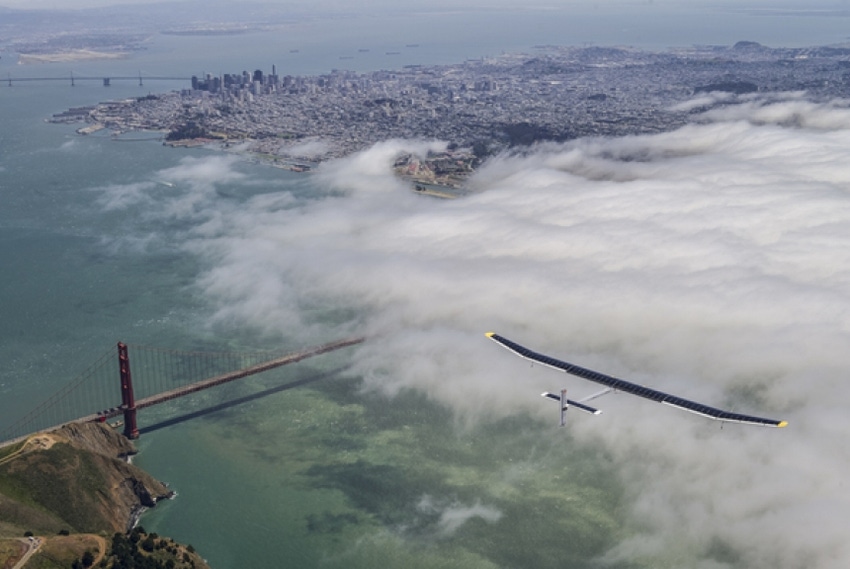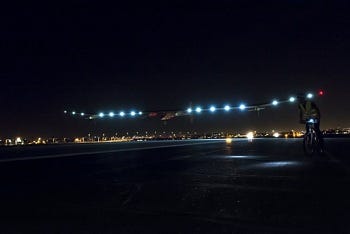Guangzhou, China - The Solar Impulse aircraft safely reached Phoenix May 5 after a 20-hour flight from San Francisco. Next up: the leg from Phoenix to Dallas which will take off the week of May 20. Traveling at an average ground speed of just 40 mph, the Solar Impulse carried its sole occupant and pilot, adventurer Bertrand Piccard, on the 650-nautical mile first leg solely utilizing the power of the sun.
May 22, 2013

Guangzhou, China - The Solar Impulse aircraft safely reached Phoenix May 5 after a 20-hour flight from San Francisco. Next up: the leg from Phoenix to Dallas which will take off the week of May 20. Traveling at an average ground speed of just 40 mph, the Solar Impulse carried its sole occupant and pilot, adventurer Bertrand Piccard, on the 650-nautical mile first leg solely utilizing the power of the sun.
|
Solar Impulse over San Francisco. |
One key to the successful transit of this the world's first solar-powered airplane capable of flying day and night without fossil fuel is specialty plastics from one of the plane's sponsors Solvay, an exhibitor at Chinaplas 2013.
Solar Impulse's long wingspan (comparable to a 747 airliner) accommodates more than 10,000 solar panels that cover the wing surface. These photovoltaic cells capture the solar energy that turns its propellers and charges its batteries for night flight. Solvay's PVDF (Solef polyvinylidene difluoride) and ECTFE (Halar, a copolymer of ethylene and chlorotrifluoroethylene) polymers are used for ultra-thin single layer films, laminated films, and adhesives that "encapsulate" the cells to reduce the impact of stressors, deformations, temperature variations and solar radiation that occur when flying. Energy captured from the photovoltaic system is stored for night flight in high-efficiency lithium batteries, which also contain PVDF.
Solvay materials also play an important role in reducing the overall weight of the aircraft. All parts that would traditionally be made of metal, including the instrument panels and control box, are instead made of ultra-light but resilient polymers. These materials, such as Solvay's polyphenylsulfone (Radel) and polyamideimide (Torlon), have densities between 1.4 and 1.8. By comparison, metals like aluminum, iron and titanium have far greater densities ranging from 2.7 to 7.9.
Further weight reduction is achieved by using hundreds of plastic screw-nut-washer systems made with Solvay's self-reinforcing polyphenylene (Primospire) - one of the stiffest and strongest unreinforced plastics in the world - rather than typical metal nuts and bolts. Other Solvay technologies aboard Solar Impulse include polyurethane foaming agent (Solkane 365mtc) for heat insulation. The result is a plane with a wing span of a jumbo jet, the total weight of a compact car, and the power of a scooter.
The Solar Impulse "Across America" mission began on May 4. It will fly across the U.S. and stop for extended visits at several cities including Washington, D.C. in June and New York in July.
About the Author(s)
You May Also Like



